Ecommerce Fulfillment Automation
Overview
When a Seattle-based, fortune 500, omni-channel retailer, needed an ecommerce fulfillment automation solution for their distribution center in Cedar Rapids, Iowa, they turned to MSI Automate for help.
Having worked with MSI Automate on a previous warehouse fulfillment system in the same DC optimized around shoes, this high-end retailer engaged MSI Automate to expand its ecommerce fulfillment automation capacities to include clothing, accessories, and cosmetics.
The goal of the new system was to accommodate increased singles orders while utilizing automation to reduce handling and packaging costs.

Video Overview
The result is an ecommerce fulfillment automation system composed of two automated packing lines that were seamlessly integrated into the material handling system that was already in place in the distribution center. The system is able to accommodate three carton sizes which can be interchanged as needed to minimize potential damage to orders, customer returns, total shipping costs, and packaging waste.
Each line is capable of completing 25 orders per minute. At this rate, MSI Automate meets this retailer’s growth projection for 2020 at over 50 orders per minute. Due to the simplicity and elegance of the ecommerce fulfillment automation design, only 4 employees are used to run the entire system. This provides our client with significantly reduced labor costs, saving them nearly $1 million dollars a year.

Operators pass inventory items under scanners before inserting into cartons so that the item UPC can be married to the carton LPN (license plate number) for 100% accuracy in order identification throughout the fulfillment process.
Situation
Rapid ecommerce business growth combined with a customer trend toward smaller orders had created a challenge for this high-end retailer’s Iowa Distribution Center. The cost of packing and shipping single piece, single line, orders was getting out of control, especially given this client’s commitment to outstanding customer service and providing a unique customer opening experience. Throw in the inconsistencies in the packaging process arising from a dependency on manual labor, and this client found itself in need of an ecommerce fulfillment automation solution.
Having worked with MSI Automate several years before when the MSI Automate Team had done the integration for a packaging line geared toward shoes in the Cedar Rapids, Iowa DC, the client called upon MSI Automate to design an additional system that would automate singles packaging for a wide array of items.
Opportunity
There was space in their Iowa facility for two new packaging lines. The facility was designed to pick orders in batch and deliver singles in groups based on common attributes like packing style. The facility had outbound conveyors already in place, and one of the requirements of the new process was that it had to be integrated not only into the building, but also into the existing material handling system already present in the building.
Some of the other key requirements to be taking in to consideration when designing the system were:
- The client was committed to utilizing its Manhattan Associates WMS, but needed some way to fill the gaps when it came to the real time requirements for carton identification, marrying inventory to the carton, packing list insertion, shipping label application, and exceptions handling.
- The existing material handling system had an inflexible WCS system that was not supportable if customized. MSI Automate would have to work within the constraints of this system, to maintain the ongoing support effort.
- The customer opening experience was of the utmost importance, requiring all items be boxed in a way that protected the item inside without making the customer deal with excess void fill or experience difficulty in opening the package.
- To meet corporate green initiatives, the client was also interested in source reduction and wanted to use the smallest, tightest, carton possible while reducing or eliminating void fill.
- The client wanted the new system to be up and running in time to meet the end of year on-line shopping rush, with enough leeway to ensure their staff was comfortable with the system and fully trained in its use.
Ecommerce Fulfillment Automation Solution
The ecommerce fulfillment system operates in the following manner:
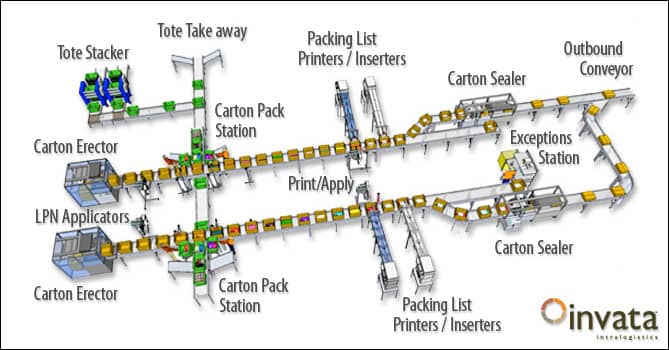
MSI Automate’s ecommerce fulfillment automation solution included two parallel automated packaging lines integrated into the existing material handling system.
At the front end of the line, a carton erector automatically constructs cartons and places them onto a conveyor that splits to feed two packaging lines. To reduce the cost of each package and increase the uptime and availability for the line as a whole, glue is used instead of tape in the carton erector to seal carton flaps.
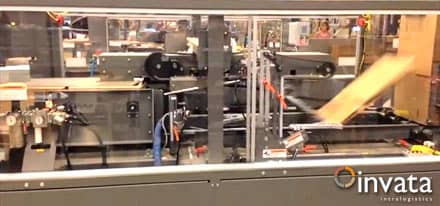
The ecommerce fulfillment automation process begins with an automated carton erector.
The carton erector is capable of producing cartons in a range of sizes. With manual intervention, it can be quickly changed over from producing one size to producing another. The change over is done using servo controls, tool-less attachments, and marked scales to guide the technician changing the line.
As soon as a carton is placed on the conveyor, it receives a bar coded LPN (or License Plate Number) label via a label applicator. This is a unique number given to each carton as it enters the automation line.
A critical step to ensuring 100% accuracy in order fulfillment, the LPN ensures that each carton used to fill an order is identified and properly tracked throughout the ecommerce fulfillment automation process. This in turn ensures that the appropriate inventory item is placed in the carton, the proper packing list is inserted, and the correct shipping label is applied without error.
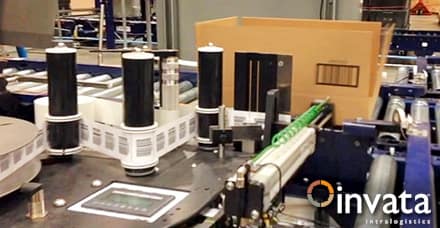
Each carton receives a unique ID as it enters the ecommerce fulfillment automation line.
Once cartons have an LPN, they are diverted left or right onto one of two parallel packaging lines and conveyed toward inventory insertion stations. On route to the stations, each empty carton passes under two nozzles that dispense fugitive glue onto the floor of the carton.
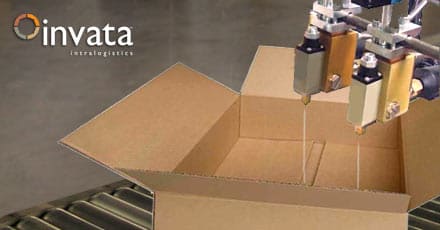
Fugitive glue secures orders without the need for void-fill, enhancing the customer opening experience.
The fugitive glue is used to secure an inventory item in the carton without the need for void fill, thus eliminating the cost of void fill. The amount of, and pattern of, the fugitive glue is controlled by a PLC directed solenoid valve. (MSI Automate’s Warehouse Execution Software offers visibility into the fugitive glue machine, minimizing down time, enabling rapid detection of machine failures, and facilitating remote support.)
At the same time fugitive glue is being dispensed, each carton’s bar code license plate is read by an in-motion ID scanner that passes the carton ID to Warehouse Control System software.
The carton then moves into the carton packing station, where totes containing picked items have been assembled to enable the single item order placement process.
Removing an inventory item from the tote, an operator passes it under a scanner before inserting it into the carton. The scanner reads the item’s UPC bar code number and transmits it to MSI Automate’s Warehouse Control System, which then associates, or marries, that item number to the LPN of the awaiting carton and makes a call to the WMS.
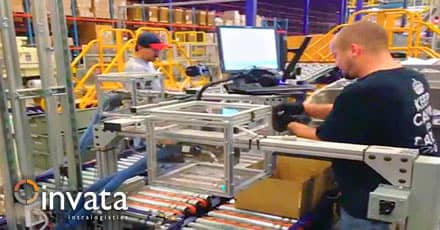
At the carton packing stations, operators pull single items from batch picked totes and insert them into awaiting cartons.
The WMS then allocates an order for the item and returns print and verification data for pack list inserting and shipping label application. Once the item has been properly inserted into the carton, the operator moves his hand past a touch-less sensor, indicating the transaction has been completed.
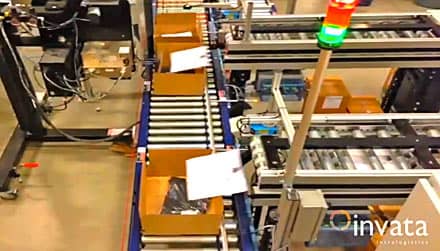
In order to allow printers sufficient time to process documents, packing list insertion is part of the the downstream ecommerce fulfillment automation process.
Once the marrying process between the item UPC and the carton ID is confirmed as correct, packing lists are printed, dispensed, and queued on a buffer conveyor down line as cartons are transferred away from induction stations onto a single conveyor for transport to the packing list inserter and labeling. Utilizing carton ID scanners, MSI Automate's warehouse software tracks each carton along the conveyor and ensure the proper packing list is dispensed into the appropriate carton.
Once inserted, the packing list is scanned by MSI Automate's software to verify that it is logically matched to the target carton.
The print and apply labeling system then prints a shipping label for each order and applies it to the appropriate carton. After a shipping label is applied, a label verification scanner and an LPN verification scanner confirm that the shipping label has been applied to the correct carton.
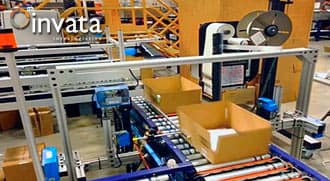
Shipping labels are side mounted and verified for accuracy.
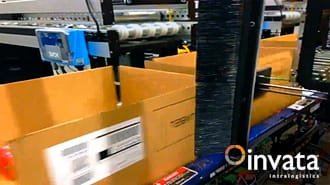
All labels are formatted to be carrier compliant.
MSI Automate's WES then makes a call to the WMS to confirm the order before cartons travel onto the carton sealer. If an exception occurs for any reason, the WES diverts the carton to the exceptions processing station where it can be properly processed. This eliminates the scenario where exceptions end up as errors-out-the-door to customers. Any carton that fails to meet a standard of 100% accuracy is pulled off the line before it goes out the door.
Once the WMS confirms the order is correct, the carton is sent through the carton sealer, where carton flaps are adhered with glue. This enhances the opening experience by making it easier to open the carton, while also reducing waste. It has the added benefit of also being less costly than other methods of carton sealing and has a higher associated machine availability and uptime than other methods.
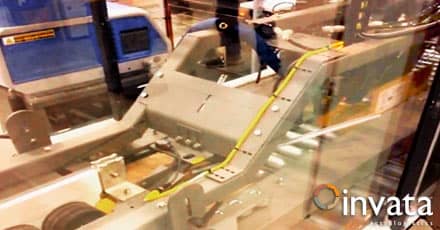
The final step in the ecommerce fulfillment automation process is carton sealing, which is only done after packages have been verified for 100% order accuracy.
Sealed cartons are then delivered to the outbound conveyor system, completing the ecommerce fulfillment automation process this client.
Additional Automation
When the totes containing picked items used at the insertion stations are emptied, they are conveyed away from the insertion stations and merged onto a main line. The totes then are diverted into a pair of tote stackers where they are automatically nested and put into tall stacks to reduce the labor needed to transport the totes back to the order selection system.
Results
The ecommerce fulfillment automation solution MSI Automate provided for this client, enables them to easily accommodate increases in ecommerce singles orders, while utilizing automation to dramatically reduce handling and packaging costs.
It also enabled the client to fully utilize the assets it had already invested in at its Iowa distribution center, including a pre-existing material handling system, a Warehouse Management System, and an inflexible Warehouse Control System. MSI Automate’s highly flexible WES Software bridged the gaps in functionality needed to enable this client to get to the next level of warehouse automation, while seamlessly integrating with the pre-existing systems.
The result is an ecommerce fulfillment automation solution that meets the client’s growth expectations through 2020 at a production rating of 3000 orders per hour, requires only 4 employees to run the entire system, and dramatically reduces labor costs while increasing order fulfillment accuracy, saving the client nearly $1 million dollars a year.
